Analysis of Stakeholder Relationships and Decision Making at Sainsbury
VerifiedAdded on 2020/02/05
|9
|1745
|74
Report
AI Summary
This report provides a detailed analysis of stakeholder management, communication, and decision-making processes within Sainsbury's, a major supermarket chain. It identifies and categorizes stakeholders, differentiating between primary (employees, customers, board of directors, shareholders, and investors) and secondary stakeholders (activist groups, media, and the general public). The report explores various methods for developing business relationships, including formal approaches like meetings, conference calls, emails, and newsletters, as well as informal methods like voice mails, hallway conversations, and social events. Furthermore, it examines the involvement of stakeholders in the decision-making process, highlighting the benefits of incorporating employee, customer, board of directors, shareholder, and investor input to foster innovation and align strategies. The report also outlines strategies for improving the decision-making process, such as clarifying hurdles, avoiding intuitive decisions, using systematic analysis, and adopting principle-based and strategic decision-making approaches. Overall, the report provides insights into the crucial role of stakeholder management and effective communication in organizational success.
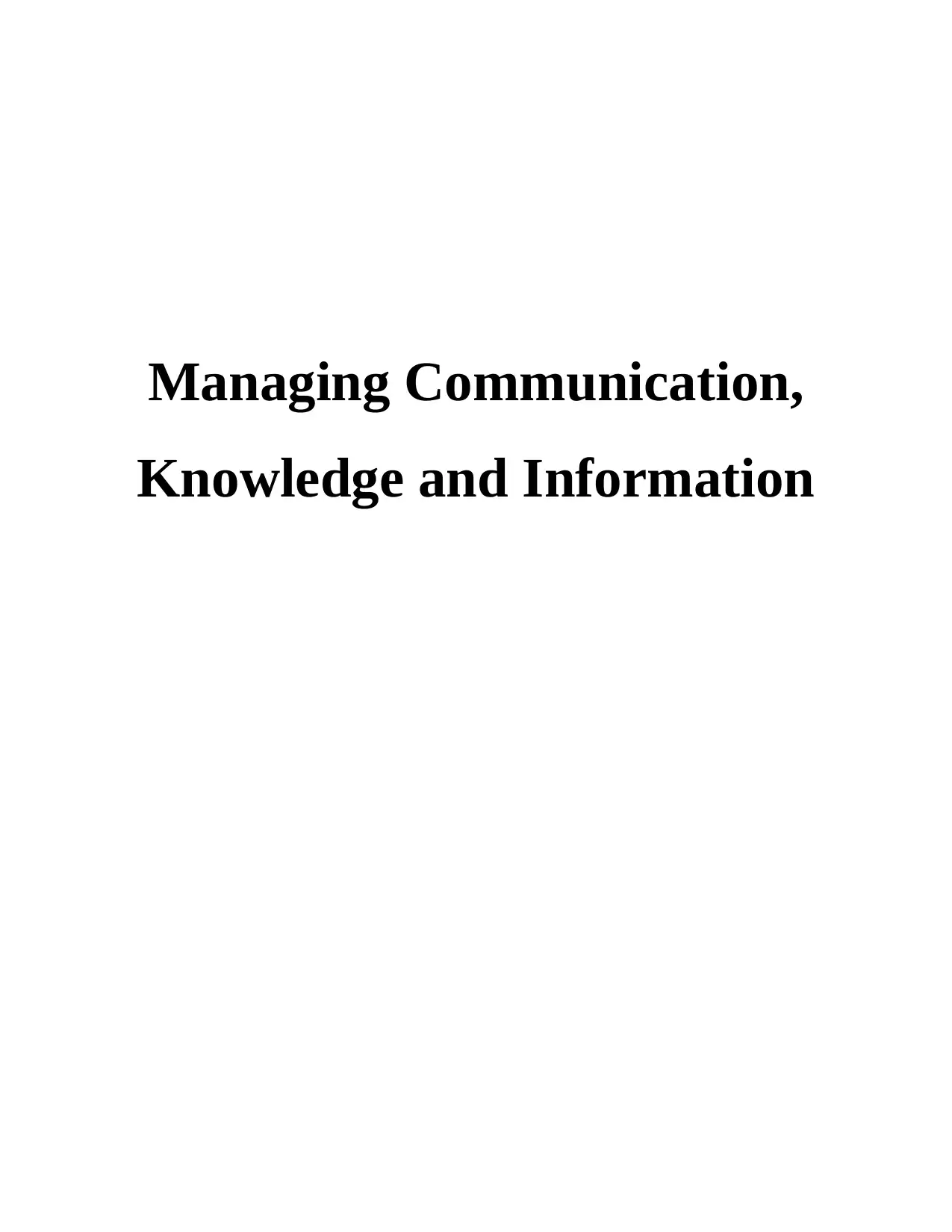
Managing Communication,
Knowledge and Information
Knowledge and Information
Paraphrase This Document
Need a fresh take? Get an instant paraphrase of this document with our AI Paraphraser
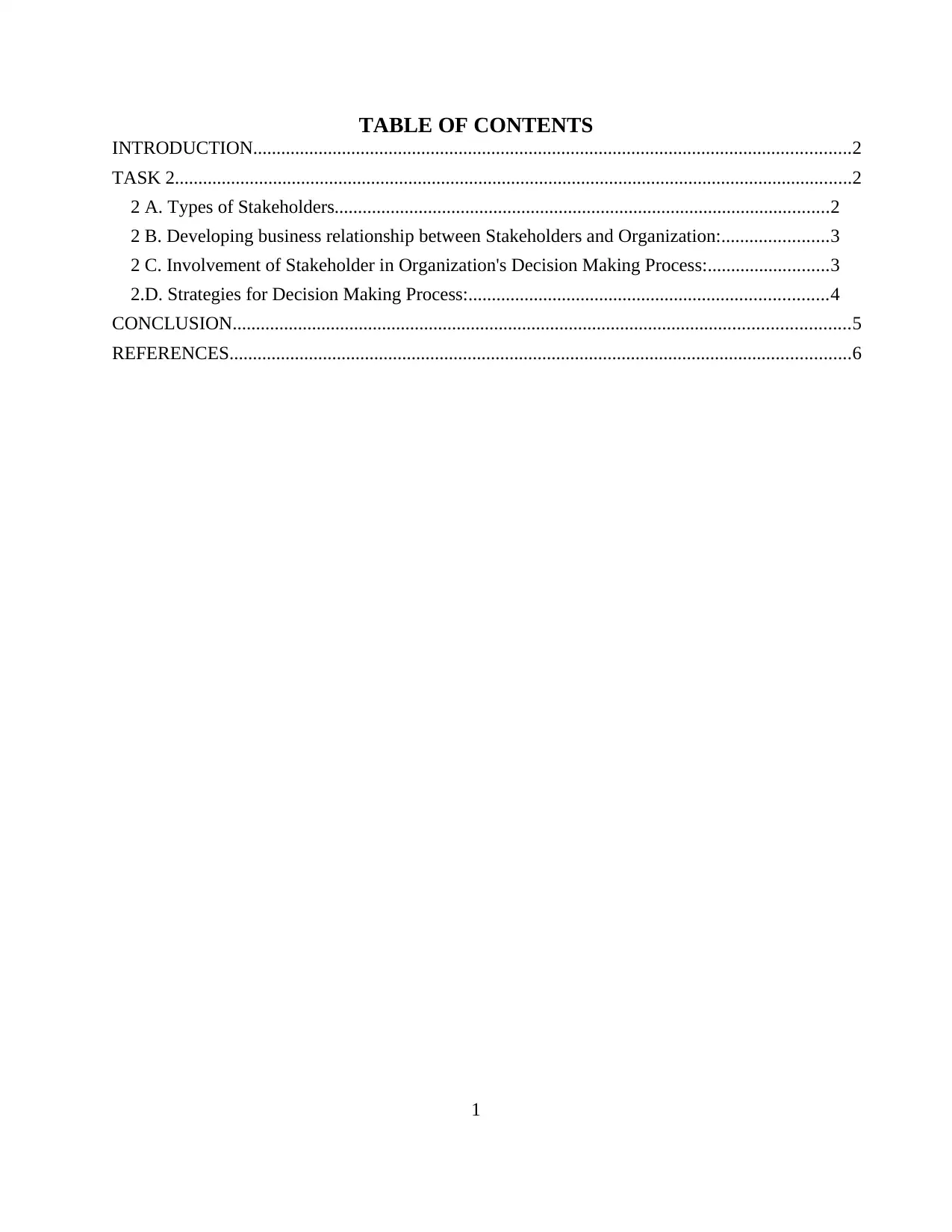
TABLE OF CONTENTS
INTRODUCTION................................................................................................................................2
TASK 2.................................................................................................................................................2
2 A. Types of Stakeholders..........................................................................................................2
2 B. Developing business relationship between Stakeholders and Organization:.......................3
2 C. Involvement of Stakeholder in Organization's Decision Making Process:..........................3
2.D. Strategies for Decision Making Process:.............................................................................4
CONCLUSION....................................................................................................................................5
REFERENCES.....................................................................................................................................6
1
INTRODUCTION................................................................................................................................2
TASK 2.................................................................................................................................................2
2 A. Types of Stakeholders..........................................................................................................2
2 B. Developing business relationship between Stakeholders and Organization:.......................3
2 C. Involvement of Stakeholder in Organization's Decision Making Process:..........................3
2.D. Strategies for Decision Making Process:.............................................................................4
CONCLUSION....................................................................................................................................5
REFERENCES.....................................................................................................................................6
1

TABLE OF FIGURES
Figure 1: Types of Stakeholder........................................................................................................2
Figure 2: Strategies for Decision Making Process..........................................................................5
2
Figure 1: Types of Stakeholder........................................................................................................2
Figure 2: Strategies for Decision Making Process..........................................................................5
2
⊘ This is a preview!⊘
Do you want full access?
Subscribe today to unlock all pages.

Trusted by 1+ million students worldwide
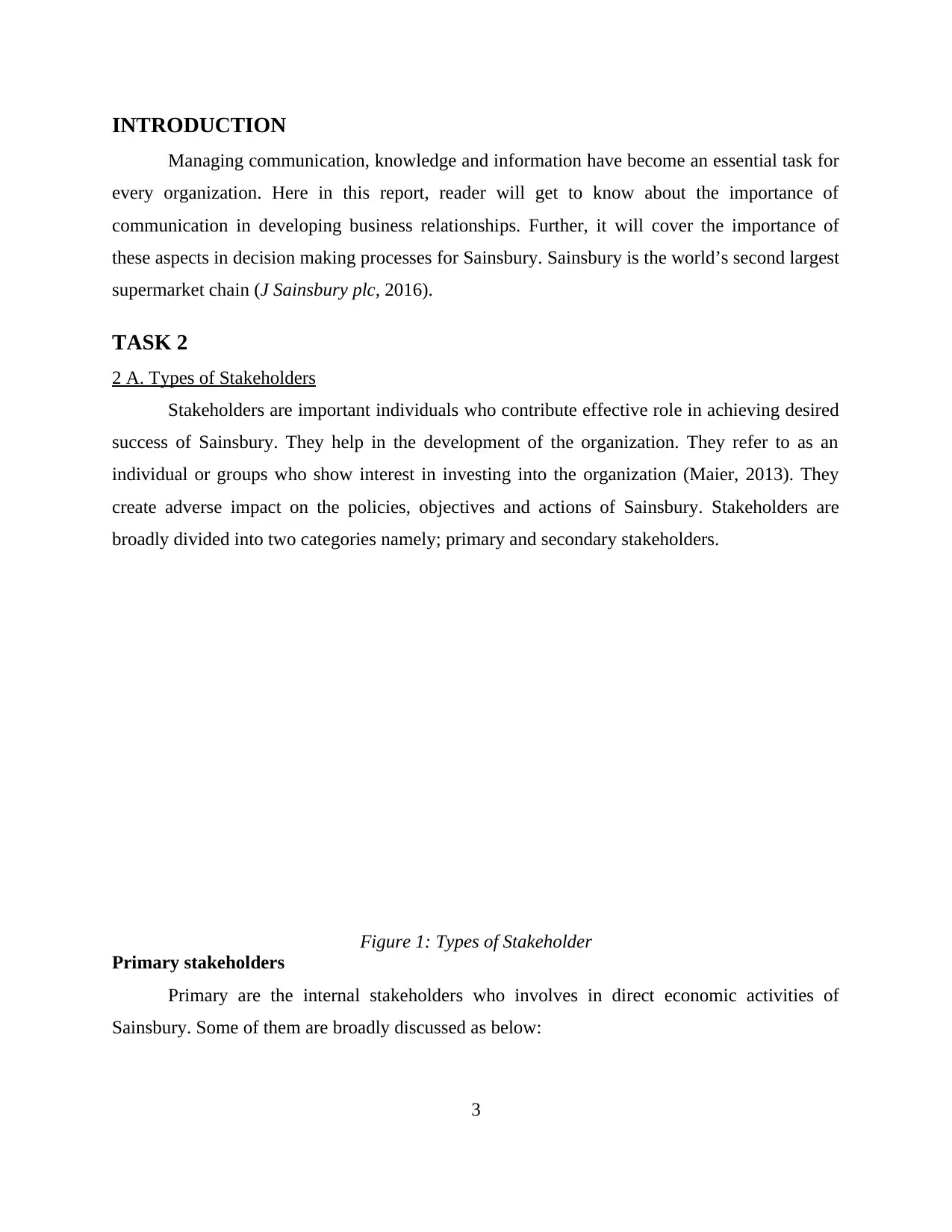
INTRODUCTION
Managing communication, knowledge and information have become an essential task for
every organization. Here in this report, reader will get to know about the importance of
communication in developing business relationships. Further, it will cover the importance of
these aspects in decision making processes for Sainsbury. Sainsbury is the world’s second largest
supermarket chain (J Sainsbury plc, 2016).
TASK 2
2 A. Types of Stakeholders
Stakeholders are important individuals who contribute effective role in achieving desired
success of Sainsbury. They help in the development of the organization. They refer to as an
individual or groups who show interest in investing into the organization (Maier, 2013). They
create adverse impact on the policies, objectives and actions of Sainsbury. Stakeholders are
broadly divided into two categories namely; primary and secondary stakeholders.
Figure 1: Types of Stakeholder
Primary stakeholders
Primary are the internal stakeholders who involves in direct economic activities of
Sainsbury. Some of them are broadly discussed as below:
3
TypesofStakeholdersPrimarystakeholdersEmployeesandCustomersBoardofDirectorsShareholdersandInvestorsSecondarystakeholdersActivistgroupsMediaGeneralpublicSupportgroupsandcommunities
Managing communication, knowledge and information have become an essential task for
every organization. Here in this report, reader will get to know about the importance of
communication in developing business relationships. Further, it will cover the importance of
these aspects in decision making processes for Sainsbury. Sainsbury is the world’s second largest
supermarket chain (J Sainsbury plc, 2016).
TASK 2
2 A. Types of Stakeholders
Stakeholders are important individuals who contribute effective role in achieving desired
success of Sainsbury. They help in the development of the organization. They refer to as an
individual or groups who show interest in investing into the organization (Maier, 2013). They
create adverse impact on the policies, objectives and actions of Sainsbury. Stakeholders are
broadly divided into two categories namely; primary and secondary stakeholders.
Figure 1: Types of Stakeholder
Primary stakeholders
Primary are the internal stakeholders who involves in direct economic activities of
Sainsbury. Some of them are broadly discussed as below:
3
TypesofStakeholdersPrimarystakeholdersEmployeesandCustomersBoardofDirectorsShareholdersandInvestorsSecondarystakeholdersActivistgroupsMediaGeneralpublicSupportgroupsandcommunities
Paraphrase This Document
Need a fresh take? Get an instant paraphrase of this document with our AI Paraphraser
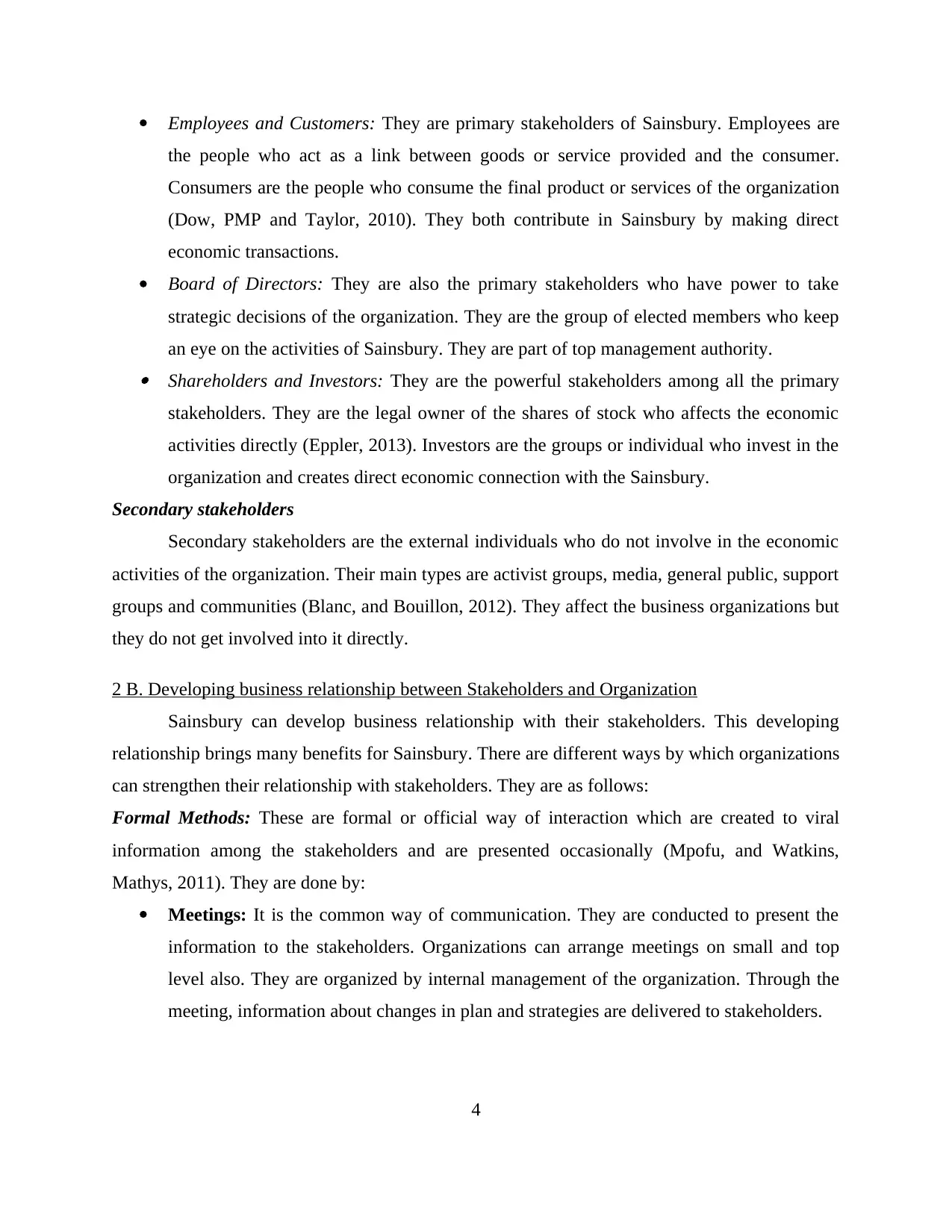
Employees and Customers: They are primary stakeholders of Sainsbury. Employees are
the people who act as a link between goods or service provided and the consumer.
Consumers are the people who consume the final product or services of the organization
(Dow, PMP and Taylor, 2010). They both contribute in Sainsbury by making direct
economic transactions.
Board of Directors: They are also the primary stakeholders who have power to take
strategic decisions of the organization. They are the group of elected members who keep
an eye on the activities of Sainsbury. They are part of top management authority. Shareholders and Investors: They are the powerful stakeholders among all the primary
stakeholders. They are the legal owner of the shares of stock who affects the economic
activities directly (Eppler, 2013). Investors are the groups or individual who invest in the
organization and creates direct economic connection with the Sainsbury.
Secondary stakeholders
Secondary stakeholders are the external individuals who do not involve in the economic
activities of the organization. Their main types are activist groups, media, general public, support
groups and communities (Blanc, and Bouillon, 2012). They affect the business organizations but
they do not get involved into it directly.
2 B. Developing business relationship between Stakeholders and Organization
Sainsbury can develop business relationship with their stakeholders. This developing
relationship brings many benefits for Sainsbury. There are different ways by which organizations
can strengthen their relationship with stakeholders. They are as follows:
Formal Methods: These are formal or official way of interaction which are created to viral
information among the stakeholders and are presented occasionally (Mpofu, and Watkins,
Mathys, 2011). They are done by:
Meetings: It is the common way of communication. They are conducted to present the
information to the stakeholders. Organizations can arrange meetings on small and top
level also. They are organized by internal management of the organization. Through the
meeting, information about changes in plan and strategies are delivered to stakeholders.
4
the people who act as a link between goods or service provided and the consumer.
Consumers are the people who consume the final product or services of the organization
(Dow, PMP and Taylor, 2010). They both contribute in Sainsbury by making direct
economic transactions.
Board of Directors: They are also the primary stakeholders who have power to take
strategic decisions of the organization. They are the group of elected members who keep
an eye on the activities of Sainsbury. They are part of top management authority. Shareholders and Investors: They are the powerful stakeholders among all the primary
stakeholders. They are the legal owner of the shares of stock who affects the economic
activities directly (Eppler, 2013). Investors are the groups or individual who invest in the
organization and creates direct economic connection with the Sainsbury.
Secondary stakeholders
Secondary stakeholders are the external individuals who do not involve in the economic
activities of the organization. Their main types are activist groups, media, general public, support
groups and communities (Blanc, and Bouillon, 2012). They affect the business organizations but
they do not get involved into it directly.
2 B. Developing business relationship between Stakeholders and Organization
Sainsbury can develop business relationship with their stakeholders. This developing
relationship brings many benefits for Sainsbury. There are different ways by which organizations
can strengthen their relationship with stakeholders. They are as follows:
Formal Methods: These are formal or official way of interaction which are created to viral
information among the stakeholders and are presented occasionally (Mpofu, and Watkins,
Mathys, 2011). They are done by:
Meetings: It is the common way of communication. They are conducted to present the
information to the stakeholders. Organizations can arrange meetings on small and top
level also. They are organized by internal management of the organization. Through the
meeting, information about changes in plan and strategies are delivered to stakeholders.
4
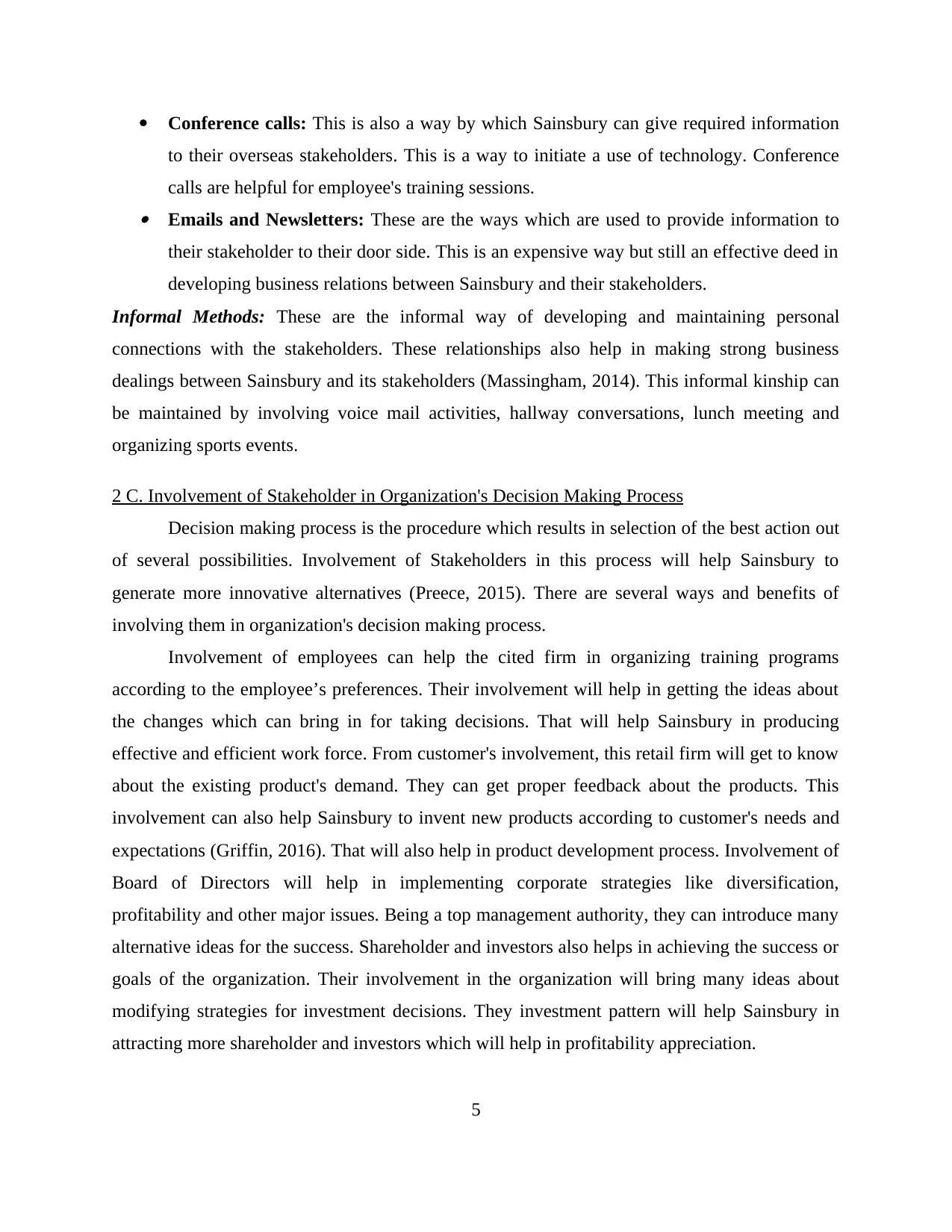
Conference calls: This is also a way by which Sainsbury can give required information
to their overseas stakeholders. This is a way to initiate a use of technology. Conference
calls are helpful for employee's training sessions. Emails and Newsletters: These are the ways which are used to provide information to
their stakeholder to their door side. This is an expensive way but still an effective deed in
developing business relations between Sainsbury and their stakeholders.
Informal Methods: These are the informal way of developing and maintaining personal
connections with the stakeholders. These relationships also help in making strong business
dealings between Sainsbury and its stakeholders (Massingham, 2014). This informal kinship can
be maintained by involving voice mail activities, hallway conversations, lunch meeting and
organizing sports events.
2 C. Involvement of Stakeholder in Organization's Decision Making Process
Decision making process is the procedure which results in selection of the best action out
of several possibilities. Involvement of Stakeholders in this process will help Sainsbury to
generate more innovative alternatives (Preece, 2015). There are several ways and benefits of
involving them in organization's decision making process.
Involvement of employees can help the cited firm in organizing training programs
according to the employee’s preferences. Their involvement will help in getting the ideas about
the changes which can bring in for taking decisions. That will help Sainsbury in producing
effective and efficient work force. From customer's involvement, this retail firm will get to know
about the existing product's demand. They can get proper feedback about the products. This
involvement can also help Sainsbury to invent new products according to customer's needs and
expectations (Griffin, 2016). That will also help in product development process. Involvement of
Board of Directors will help in implementing corporate strategies like diversification,
profitability and other major issues. Being a top management authority, they can introduce many
alternative ideas for the success. Shareholder and investors also helps in achieving the success or
goals of the organization. Their involvement in the organization will bring many ideas about
modifying strategies for investment decisions. They investment pattern will help Sainsbury in
attracting more shareholder and investors which will help in profitability appreciation.
5
to their overseas stakeholders. This is a way to initiate a use of technology. Conference
calls are helpful for employee's training sessions. Emails and Newsletters: These are the ways which are used to provide information to
their stakeholder to their door side. This is an expensive way but still an effective deed in
developing business relations between Sainsbury and their stakeholders.
Informal Methods: These are the informal way of developing and maintaining personal
connections with the stakeholders. These relationships also help in making strong business
dealings between Sainsbury and its stakeholders (Massingham, 2014). This informal kinship can
be maintained by involving voice mail activities, hallway conversations, lunch meeting and
organizing sports events.
2 C. Involvement of Stakeholder in Organization's Decision Making Process
Decision making process is the procedure which results in selection of the best action out
of several possibilities. Involvement of Stakeholders in this process will help Sainsbury to
generate more innovative alternatives (Preece, 2015). There are several ways and benefits of
involving them in organization's decision making process.
Involvement of employees can help the cited firm in organizing training programs
according to the employee’s preferences. Their involvement will help in getting the ideas about
the changes which can bring in for taking decisions. That will help Sainsbury in producing
effective and efficient work force. From customer's involvement, this retail firm will get to know
about the existing product's demand. They can get proper feedback about the products. This
involvement can also help Sainsbury to invent new products according to customer's needs and
expectations (Griffin, 2016). That will also help in product development process. Involvement of
Board of Directors will help in implementing corporate strategies like diversification,
profitability and other major issues. Being a top management authority, they can introduce many
alternative ideas for the success. Shareholder and investors also helps in achieving the success or
goals of the organization. Their involvement in the organization will bring many ideas about
modifying strategies for investment decisions. They investment pattern will help Sainsbury in
attracting more shareholder and investors which will help in profitability appreciation.
5
⊘ This is a preview!⊘
Do you want full access?
Subscribe today to unlock all pages.

Trusted by 1+ million students worldwide
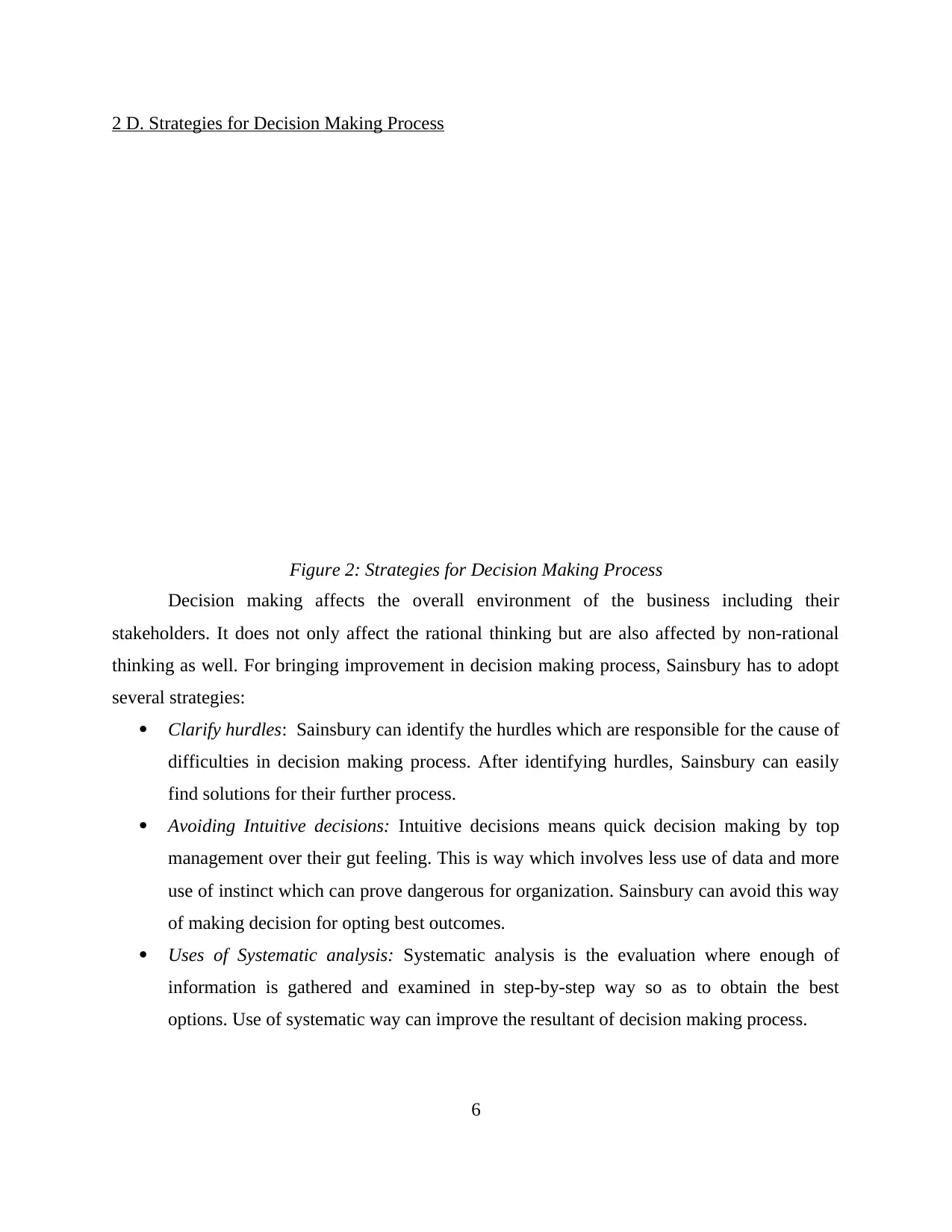
2 D. Strategies for Decision Making Process
Figure 2: Strategies for Decision Making Process
Decision making affects the overall environment of the business including their
stakeholders. It does not only affect the rational thinking but are also affected by non-rational
thinking as well. For bringing improvement in decision making process, Sainsbury has to adopt
several strategies:
Clarify hurdles: Sainsbury can identify the hurdles which are responsible for the cause of
difficulties in decision making process. After identifying hurdles, Sainsbury can easily
find solutions for their further process.
Avoiding Intuitive decisions: Intuitive decisions means quick decision making by top
management over their gut feeling. This is way which involves less use of data and more
use of instinct which can prove dangerous for organization. Sainsbury can avoid this way
of making decision for opting best outcomes.
Uses of Systematic analysis: Systematic analysis is the evaluation where enough of
information is gathered and examined in step-by-step way so as to obtain the best
options. Use of systematic way can improve the resultant of decision making process.
6
StrategiesforDecisionMakingProcess
Figure 2: Strategies for Decision Making Process
Decision making affects the overall environment of the business including their
stakeholders. It does not only affect the rational thinking but are also affected by non-rational
thinking as well. For bringing improvement in decision making process, Sainsbury has to adopt
several strategies:
Clarify hurdles: Sainsbury can identify the hurdles which are responsible for the cause of
difficulties in decision making process. After identifying hurdles, Sainsbury can easily
find solutions for their further process.
Avoiding Intuitive decisions: Intuitive decisions means quick decision making by top
management over their gut feeling. This is way which involves less use of data and more
use of instinct which can prove dangerous for organization. Sainsbury can avoid this way
of making decision for opting best outcomes.
Uses of Systematic analysis: Systematic analysis is the evaluation where enough of
information is gathered and examined in step-by-step way so as to obtain the best
options. Use of systematic way can improve the resultant of decision making process.
6
StrategiesforDecisionMakingProcess
Paraphrase This Document
Need a fresh take? Get an instant paraphrase of this document with our AI Paraphraser
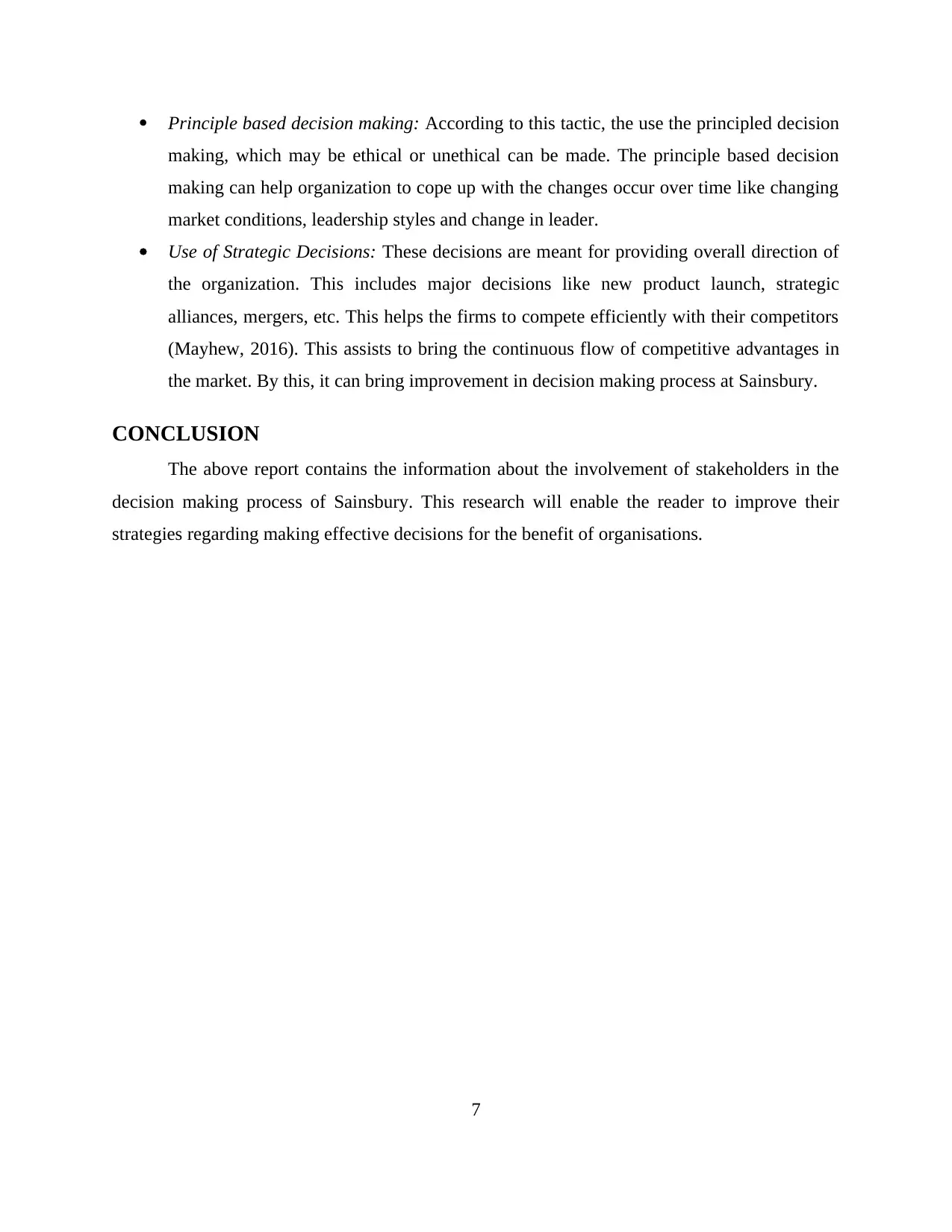
Principle based decision making: According to this tactic, the use the principled decision
making, which may be ethical or unethical can be made. The principle based decision
making can help organization to cope up with the changes occur over time like changing
market conditions, leadership styles and change in leader.
Use of Strategic Decisions: These decisions are meant for providing overall direction of
the organization. This includes major decisions like new product launch, strategic
alliances, mergers, etc. This helps the firms to compete efficiently with their competitors
(Mayhew, 2016). This assists to bring the continuous flow of competitive advantages in
the market. By this, it can bring improvement in decision making process at Sainsbury.
CONCLUSION
The above report contains the information about the involvement of stakeholders in the
decision making process of Sainsbury. This research will enable the reader to improve their
strategies regarding making effective decisions for the benefit of organisations.
7
making, which may be ethical or unethical can be made. The principle based decision
making can help organization to cope up with the changes occur over time like changing
market conditions, leadership styles and change in leader.
Use of Strategic Decisions: These decisions are meant for providing overall direction of
the organization. This includes major decisions like new product launch, strategic
alliances, mergers, etc. This helps the firms to compete efficiently with their competitors
(Mayhew, 2016). This assists to bring the continuous flow of competitive advantages in
the market. By this, it can bring improvement in decision making process at Sainsbury.
CONCLUSION
The above report contains the information about the involvement of stakeholders in the
decision making process of Sainsbury. This research will enable the reader to improve their
strategies regarding making effective decisions for the benefit of organisations.
7
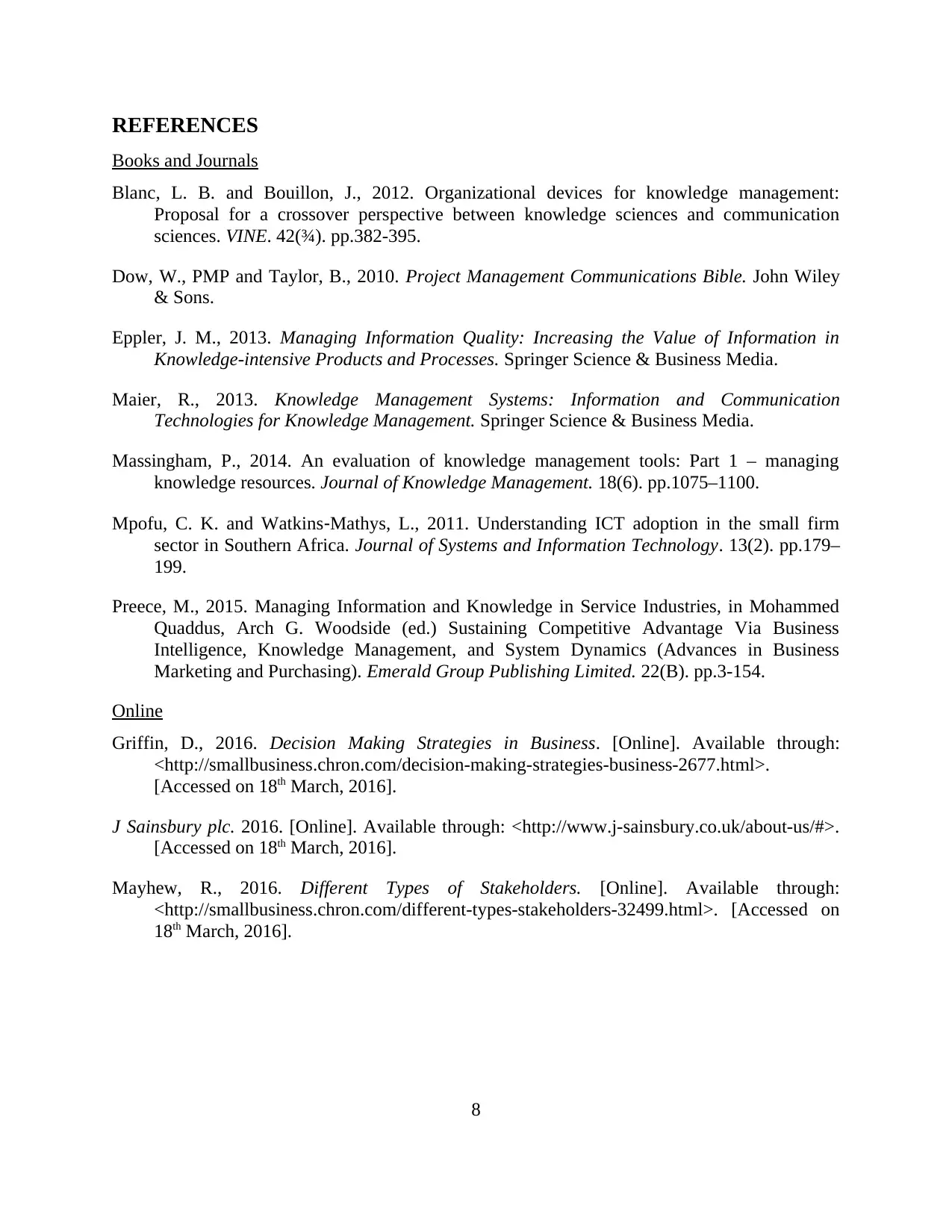
REFERENCES
Books and Journals
Blanc, L. B. and Bouillon, J., 2012. Organizational devices for knowledge management:
Proposal for a crossover perspective between knowledge sciences and communication
sciences. VINE. 42(¾). pp.382-395.
Dow, W., PMP and Taylor, B., 2010. Project Management Communications Bible. John Wiley
& Sons.
Eppler, J. M., 2013. Managing Information Quality: Increasing the Value of Information in
Knowledge-intensive Products and Processes. Springer Science & Business Media.
Maier, R., 2013. Knowledge Management Systems: Information and Communication
Technologies for Knowledge Management. Springer Science & Business Media.
Massingham, P., 2014. An evaluation of knowledge management tools: Part 1 – managing
knowledge resources. Journal of Knowledge Management. 18(6). pp.1075–1100.
Mpofu, C. K. and Watkins‐Mathys, L., 2011. Understanding ICT adoption in the small firm
sector in Southern Africa. Journal of Systems and Information Technology. 13(2). pp.179–
199.
Preece, M., 2015. Managing Information and Knowledge in Service Industries, in Mohammed
Quaddus, Arch G. Woodside (ed.) Sustaining Competitive Advantage Via Business
Intelligence, Knowledge Management, and System Dynamics (Advances in Business
Marketing and Purchasing). Emerald Group Publishing Limited. 22(B). pp.3-154.
Online
Griffin, D., 2016. Decision Making Strategies in Business. [Online]. Available through:
<http://smallbusiness.chron.com/decision-making-strategies-business-2677.html>.
[Accessed on 18th March, 2016].
J Sainsbury plc. 2016. [Online]. Available through: <http://www.j-sainsbury.co.uk/about-us/#>.
[Accessed on 18th March, 2016].
Mayhew, R., 2016. Different Types of Stakeholders. [Online]. Available through:
<http://smallbusiness.chron.com/different-types-stakeholders-32499.html>. [Accessed on
18th March, 2016].
8
Books and Journals
Blanc, L. B. and Bouillon, J., 2012. Organizational devices for knowledge management:
Proposal for a crossover perspective between knowledge sciences and communication
sciences. VINE. 42(¾). pp.382-395.
Dow, W., PMP and Taylor, B., 2010. Project Management Communications Bible. John Wiley
& Sons.
Eppler, J. M., 2013. Managing Information Quality: Increasing the Value of Information in
Knowledge-intensive Products and Processes. Springer Science & Business Media.
Maier, R., 2013. Knowledge Management Systems: Information and Communication
Technologies for Knowledge Management. Springer Science & Business Media.
Massingham, P., 2014. An evaluation of knowledge management tools: Part 1 – managing
knowledge resources. Journal of Knowledge Management. 18(6). pp.1075–1100.
Mpofu, C. K. and Watkins‐Mathys, L., 2011. Understanding ICT adoption in the small firm
sector in Southern Africa. Journal of Systems and Information Technology. 13(2). pp.179–
199.
Preece, M., 2015. Managing Information and Knowledge in Service Industries, in Mohammed
Quaddus, Arch G. Woodside (ed.) Sustaining Competitive Advantage Via Business
Intelligence, Knowledge Management, and System Dynamics (Advances in Business
Marketing and Purchasing). Emerald Group Publishing Limited. 22(B). pp.3-154.
Online
Griffin, D., 2016. Decision Making Strategies in Business. [Online]. Available through:
<http://smallbusiness.chron.com/decision-making-strategies-business-2677.html>.
[Accessed on 18th March, 2016].
J Sainsbury plc. 2016. [Online]. Available through: <http://www.j-sainsbury.co.uk/about-us/#>.
[Accessed on 18th March, 2016].
Mayhew, R., 2016. Different Types of Stakeholders. [Online]. Available through:
<http://smallbusiness.chron.com/different-types-stakeholders-32499.html>. [Accessed on
18th March, 2016].
8
⊘ This is a preview!⊘
Do you want full access?
Subscribe today to unlock all pages.

Trusted by 1+ million students worldwide
1 out of 9
Related Documents
Your All-in-One AI-Powered Toolkit for Academic Success.
+13062052269
info@desklib.com
Available 24*7 on WhatsApp / Email
![[object Object]](/_next/static/media/star-bottom.7253800d.svg)
Unlock your academic potential
Copyright © 2020–2025 A2Z Services. All Rights Reserved. Developed and managed by ZUCOL.





